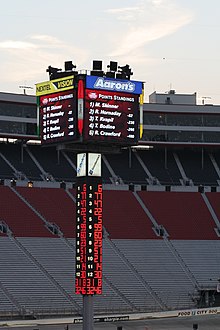Bristol Motor Speedway, formerly known as Bristol International Raceway and Bristol Raceway, is a NASCAR short track located in Bristol, Tennessee. Constructed in 1960, it held its first NASCAR race on July 30, 1961. Bristol is among the most popular tracks on the NASCAR schedule because of its distinct features, which include extraordinarily steep banking, an all-concrete surface, two pit roads, different turn radii, and stadium-like seating. It has also been named one of the loudest NASCAR tracks.
Bristol Motor Speedway is the fourth-largest sports venue in America and the tenth largest in the world, seating up to 146,000 people. The speeds are far lower than is typical on most NASCAR oval tracks, but they are very fast compared to other short tracks due to the high banking. Those features make for a considerable amount of car contact at the NASCAR races as the initial starting grid of 40 vehicles each in the Cup and Xfinity Series, and 32 in the Truck Series, extends almost halfway around the track, meaning slower qualifiers begin the race almost half a lap down.

Grandstand in 2007
The drag strip at this facility has long been nicknamed "Thunder Valley". Both NASCAR Cup Series races held at Bristol are for 500 laps; the spring race (historically a day race; however, the 2006 race ended under nighttime conditions because of Standard Time and the late afternoon start) is sponsored by area grocery chain Food City and considered one of NASCAR's top 10 annual races.[2] The late summer race (the popular night-time race, considered "the toughest ticket in NASCAR" to obtain) has rotated among several sponsors. From 2001 to 2015, Newell Rubbermaid sponsored the race, first under its Sharpie brand (2001–2009) and then its Irwin Tools brand (2010–2015). From 2016 to 2021, Bass Pro Shops became primary sponsor of the summer race, with the National Rifle Association as a secondary sponsor. In 2022, Bass Pro Shops became the sole entitlement sponsor of Bristol's September NASCAR Playoff Race.
The drag strip at this facility has long been nicknamed "Thunder Valley". Both NASCAR Cup Series races held at Bristol are for 500 laps; the spring race (historically a day race; however, the 2006 race ended under nighttime conditions because of Standard Time and the late afternoon start) is sponsored by area grocery chain Food City and considered one of NASCAR's top 10 annual races.[2] The late summer race (the popular night-time race, considered "the toughest ticket in NASCAR" to obtain) has rotated among several sponsors. From 2001 to 2015, Newell Rubbermaid sponsored the race, first under its Sharpie brand (2001–2009) and then its Irwin Tools brand (2010–2015). From 2016 to 2021, Bass Pro Shops became primary sponsor of the summer race, with the National Rifle Association as a secondary sponsor. In 2022, Bass Pro Shops became the sole entitlement sponsor of Bristol's September NASCAR Playoff Race.
The old scoring pylon in August 2007
Bristol is a fertile ground for other levels and types of racing; NASCAR Xfinity Series races often draw more than 100,000 spectators, making it one of the best-drawing Xfinity venues, and resulted in Fox televising the race nationally from 2004 to 2006 and ABC doing the same in 2007 and 2008.
In 2004, it was the first Busch Series race of the season televised on broadcast network television, and the race, which had been 150 laps in 1982, 200 laps in 1984, and 250 laps since 1990, was a 300-lap race in 2006. READ MORE...
Bristol is a fertile ground for other levels and types of racing; NASCAR Xfinity Series races often draw more than 100,000 spectators, making it one of the best-drawing Xfinity venues, and resulted in Fox televising the race nationally from 2004 to 2006 and ABC doing the same in 2007 and 2008.
In 2004, it was the first Busch Series race of the season televised on broadcast network television, and the race, which had been 150 laps in 1982, 200 laps in 1984, and 250 laps since 1990, was a 300-lap race in 2006. READ MORE...









